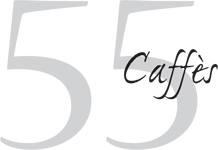

“THE DEVIL’S DRINK” IS WHAT COFFEE was called when it first came to Venice on trade ships from North Africa in the sixteenth century. While wealthy Venetians were having a gay old time getting hopped up on it, pious peeps ran to Pope Clement VIII and urged him to ban it. The Pope figured he should at least have a taste first. He took one sip, declared it would be a sin not to drink this delicious gift from God, and blessed it. Now Italians drink 14 billion cups of coffee a year.
Caffès are happening places in Italy. In a Verona caffè in 1983, Howard Schultz looked around at everyone enjoying themselves so much that he went home to America and created Starbucks.
As far as Italy’s caffè styles, you have many to pick from for your postcard writing, people watching, Devil’s Drink break.
If you’re in the mood to go fancy, you can splurge in one of Italy’s historical caffès, some of which have been around for 300 years. Every Italian city has at least one of these classic places, where you’re seated in a jewel-box of a salon and waited on by tuxedoed waiters. All have lists of illustrious travelers who have come before you—from queens to writers like Oscar Wilde to stars like Eleonora Duse. They are also great stops for evening cocktails, and offer delicious sweets and snacks. You’ll pay a lot less if you stand at their counters, but come on, you’re on vacation, so you might as well settle in. You’re not going to end up some old lady eating cat food and muttering, “Oh, if I only hadn’t spent ten euros for that cappuccino at the Florian...” Go for it.
If you’re feeling more like people watching and mingling with the locals, there are caffès that have rich traditions of being gathering places for artists and intellectuals.
And finally, if you want to go to a place that’s legendary for serving the absolute best coffee in each city, I’ve listed them below. After you elbow in with the locals at the bar for your drink, you can buy a bag of beans to bring home.
Rome
This caffè was founded by a Greek man in 1760, thus the name. Amidst the elegant surroundings, check out the photo of Buffalo Bill, whose 1906 visit caused a sensation.
Established in Rome’s “Piazza of the People” in 1922, this elegant caffe became popular with left-wing journalists and writers, such as Italo Calvino and Alberto Moravia. Score an outdoor table for afternoon caffe or evening aperitivo to watch the entertaining flow of tourists and high-heeled locals.
Florence
This began as a confectioner’s shop in 1733, and moved here in the early 1900s. Now it’s the place to have your espresso in airy belle époque surroundings with wonderful pastries and buy their delizioso chocolates.
Tucked into a enchanting square in the Oltrarno, this caffe began in 1945 as a gathering place for the neighborhood’s artigiani (artisans). Today it’s popular with locals and students, who enjoy its cozy interior for winter-time tea or sidewalk seating for evening prosecco.
Superstar barista Francesco Sanapo founded this modern institution in 2013, which features carefully selected sourced beans, a variety of brewing options, and even American-style breakfasts—eggs and pancakes.
Venice
Opened in 1720, this is Italy’s oldest and most divine caffè. Casanova enjoyed coming here because it was the only place at the time that admitted women. It’s marvelous to tuck into one of the velvet banquettes inside on a chilly morning, and in the evening take a table outside with a view of the piazza—when the orchestra starts up it feels like you’re in a dream world.
Since 1879, this family-run operation has been the top catering company in Venice. Settle in for tea, hot chocolate, or caffe and refined Venetian pastries.
Naples
Since 1850, here’s where you can sit ensconced in a stunning art nouveau atmosphere, and enjoy an orchestra on Saturday nights.
A lively caffè, tea salon and bookshop, run by the wonderful Lia Polcari. It’s headquarters for the Evaluna Association that, since the 1970s, has been publishing books by women authors.
Turin
Since 1858, hot chocolate, thick as pudding, is what to order here, and they’ve got great house-made chocolates, like gianduiotti (hazelnut chocolate) and liqueur-filled goodies to bring home. My friend Emanuela, a Torino native, called it “the caffè for principessas” when she was a child.
Since 1763, this teeny, welcoming place has served bicerin, Torino’s famous drink of espresso, chocolate, and whipped cream. Though founded by a man, it has been operated by women since its start, and traditionally welcomed female customers to stop by after mass at the church across the piazza.
This is where the famous company originated in 1895. Lots of other locations in Turin.
RECOMMENDED READING
Café Life series (Rome, Florence, and Venice) by Joe Wolff